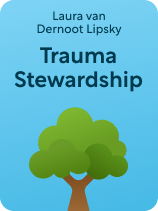

This article is an excerpt from the Shortform book guide to "Trauma Stewardship" by Laura van Dernoot Lipsky. Shortform has the world's best summaries and analyses of books you should be reading.
Like this article? Sign up for a free trial here.
What’s the importance of self-reflection? How does reflecting on yourself help workers in trauma care?
People who help others cope with their trauma should be praised for the work they do. But these heroes sometimes forget that they need to take care of themselves, as well.
If you’re one of these people, keep reading to learn how to self-reflect and improve your health.
How to Make Time for Reflection
According to Laura van Dernoot Lipsky’s book Trauma Stewardship, embracing a more mindful approach to trauma care means regularly knowing how to self-reflect on your needs, motivations, and emotions. You can do this by setting aside a small window of time in the morning for reflection. You can also practice meditation and breathing exercises.
Lipsky explains that understanding ourselves is key to processing the effects that secondary trauma has on us. Often, we get so caught up in our daily routines and work stresses that we lose connection to our personal needs and the reasons why we wanted to help others in the first place. This can cause us to feel like we have no control or options in our lives when we really do.
(Shortform note: In Who Will Cry When You Die?, Robin Sharma recommends you reflect on your purpose every morning and at the end of each day to be more connected to your personal needs, purpose, and motivations. He argues that thinking about your purpose every morning allows you to eliminate unnecessary obligations from your schedule. Every night, Sharma suggests you reflect on your purpose by writing about any lessons and experiences you had during the day. This helps you assess whether you’re living according to your purpose so that you can better adjust your mindset and actions tomorrow.)
When you practice reflection, ask yourself: “What is my reason for doing what I’m doing?” This question helps you realize that trauma doesn’t control you and that you have a choice in what to focus on when working with trauma. Lipsky recommends you discuss your reasons with people you trust or write them down as a reminder for the future. As you reflect on your reasons, consider whether continuing in your current work is good for your health. It’s possible that the work you do may no longer be in your best interest if it’s negatively impacting your well-being.
(Shortform note: Beyond posing yourself questions or discussing your reasons with others, consider visualizing a personal wellness meter to regularly assess your needs and determine whether your work has become harmful to your well-being. Imagine your meter has a green zone, a yellow zone, and a red zone, with green meaning you’re at your best and red meaning you’re distressed and overwhelmed. Picture in detail how it might look and imagine putting it on a dock that tells you how much stress and trauma you experienced during the entire workday.)
One reason many people engage in trauma work, Lipsky explains, is a desire for trauma mastery—a coping mechanism to recapture a sense of control that they didn’t have during a past traumatic experience. For example, you might work in the medical field if you had lost a loved one to illness when you were younger.
If trauma mastery is part of the reason you pursue your line of work, Lipsky advises that you seek support and healing for your original trauma so you don’t use your work as the main way to cope with your trauma. People with personal stakes tied to their work, she argues, might put an unhealthy amount of pressure on themselves. One way you can better understand how to manage your desire for trauma mastery while working with the trauma of others is by studying how others have dealt with their personal trauma while involved in trauma work.
(Shortform note: The urge to reengage with your past trauma is called repetition compulsion. According to psychologists, this compulsion happens when you’re unable to resolve or heal your former trauma. This causes some trauma survivors to want to repeat similar situations and causes others to engage in trauma work as a way to regain a sense of control. Pursuing trauma mastery can be damaging because repeating traumatic events rarely leads to a feeling of mastery and only increases your exposure to trauma. However, certain variations of reenactment, like telling stories about a deceased loved one, may have positive effects for coping with the trauma of the loss.)

———End of Preview———
Like what you just read? Read the rest of the world's best book summary and analysis of Laura van Dernoot Lipsky's "Trauma Stewardship" at Shortform.
Here's what you'll find in our full Trauma Stewardship summary:
- That the best way to care for others is to care for yourself
- How trauma damages the caregivers who are exposed to others' trauma
- How caregivers can manage secondary trauma to better support others






